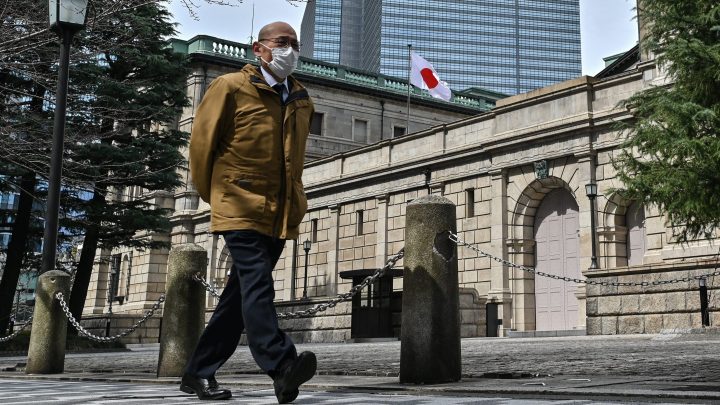
The Bank of Japan is having a normal one

An end to negative interest rates. While many of the world’s largest economies have been batting back runaway inflation, Japan’s has struggled with too little. Its economy has been one of stagnation and deflation since the early ’90s, and it recently squeaked out of a technical recession. (Remember, economists believe some inflation is good.) Japan needed more consumers and investors to spend more of their money to stimulate the economy. The Bank of Japan set interest rates at negative levels, effectively charging banks to deposit and store money with it.
Now that Japan’s inflation rate has cleared its 2% target for almost two years, the BOJ seems assured enough that higher inflation isn’t just a transitory blip. It raised rates from -0.1% to a range of 0 to 0.1% on Tuesday, returning to “normal” monetary policy.
Bye-bye YCC! The BOJ also announced this week it would stop managing the economy via the “yield control curve,” a less traditional monetary policy that central banks use to encourage growth when short-term interest rates are near or at zero. Central banks more often turn to quantitative easing to manage growth — the Federal Reserve used QE to boost the economy during the Great Recession and in response to the COVID-19 pandemic.
What does “curing deflation” mean for Japan? Before he became Federal Reserve chair in 2006, Ben Bernanke said fixing deflation would restore Japan’s economic health. But the impact of returning to low, positive inflation may be hard to pinpoint, at least in the short term. Japanese consumers aren’t spending a lot. Raising rates will make loans more expensive and could hurt already cash-strapped parts of the economy like traditional ryokan inns.
Meanwhile, the Federal Reserve is keeping rates high in the U.S. Chair Jerome Powell said Wednesday he wants to see more good data showing inflation is under control before the central bank cuts interest rates.
Smart in a shot

Does art imitate life or influence it? Hollywood would have you think bank robbers are master planners — armed to the teeth, technically gifted, impeccably dressed and disproportionately Bostonian.
But Federal Bureau of Investigation data tells us real-life bank robberies have dropped dramatically in recent decades, and they only get violent 3% of the time.
Despite the hard data, bank security systems are heavily influenced by the movies —many real-life banks have taken cues from cinematic heists, adding security cameras, armed guards, loud alarm systems — because that’s what people who’ve watched a lot of heist films expect.
“In reality, alarms and cameras don’t stop robberies,” Walt Hickey writes in his 2023 book, “You Are What You Watch: How Movies and TV Affect Everything.” “The reason for half the bells and whistles in your standard bank is to appease the public’s desire for ostentatious displays of security.”
When robberies happen, they don’t play out like the movies. Thieves are more likely to hand a note to a teller, silently demanding money, than they are to crack into a vault. And they typically walk away with small bounties — an average of $9,295 in 2013. Hickey analyzed 190 heist films made from 1930 to 2018 to find Hollywood’s staged robberies involved sums much higher, an average of $22.2 million.
The Numbers
We got new data last week on book censorship in schools and public libraries last year. Let’s do the numbers.
4,240
The number of titles challenged last year, according to the American Library Association. That’s up 65% from 2022, which had a record 2,571 titles.
47%
According to the ALA, nearly half of titles challenged in 2023 contain “the voices and lived experiences of LGBTQIA+ and BIPOC individuals.”
2
Just two states, Delaware and Vermont, went the whole year without a censorship attempt. Here’s an interactive map showing the number of titles challenged and ban attempts by state.
$3.6 million
That’s the estimated cost Texas taxpayers would incur reviewing the 1,470 books challenged in the state last year, according to advocacy group EveryLibrary.
None of us is as smart as all of us
Tell us what’s making you smarter at smarter@marketplace.org. We’d love to include your recommendation in a future newsletter.
Tell us what’s making you smarter at smarter@marketplace.org. We’d love to include your recommendation in a future newsletter.
Digital decay
Host Kimberly Adams is reading a Hollywood Reporter article about the future of digital film preservation. Many digital formats face serious risk of complete decay due to file corruptions, improper transfers, format changes and hard drive failures.
Ghostbusters
Editor Stephanie Siek is reading a BBC article that explores the rise of “ghost jobs” — jobs that companies post as available, but never end up hiring for. Some jobseekers are changing their tactics for finding employment as a result.
A whole new experience
Editor Virginia K. Smith is reading a Washington Post story about how toilet paper shortages early in the COVID-19 pandemic fueled bidet sales, converting many Americans into fans of other countries’ longtime bathroom staple.
There’s a lot happening in the world. Through it all, Marketplace is here for you.
You rely on Marketplace to break down the world’s events and tell you how it affects you in a fact-based, approachable way. We rely on your financial support to keep making that possible.
Your donation today powers the independent journalism that you rely on. For just $5/month, you can help sustain Marketplace so we can keep reporting on the things that matter to you.

















